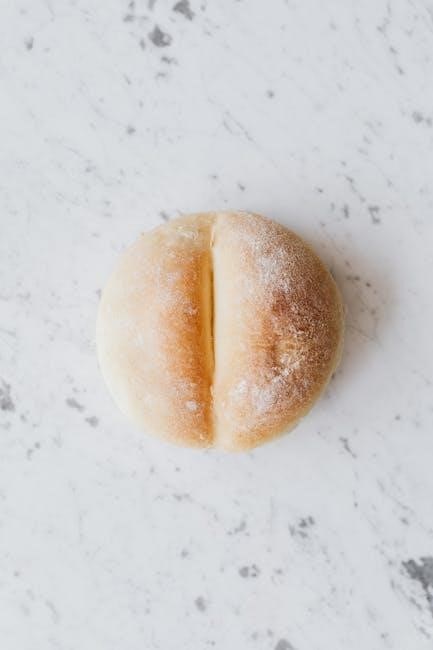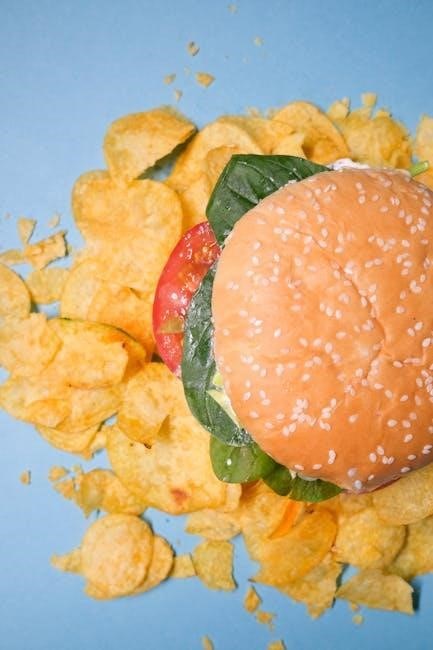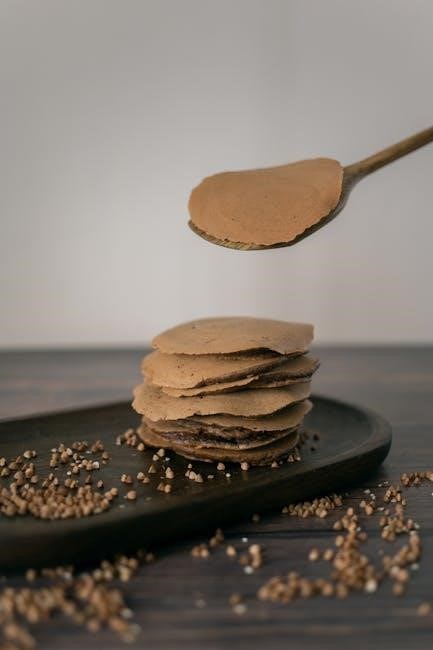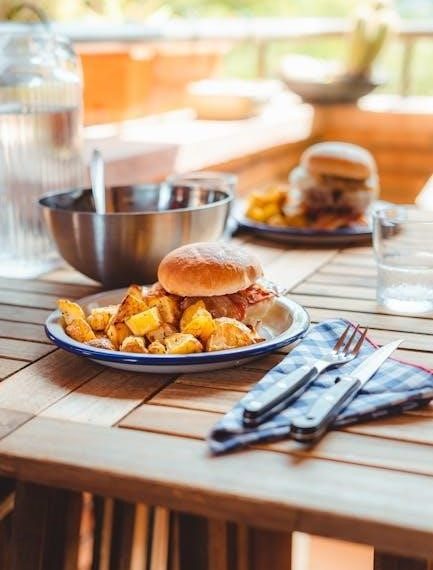1900 calorie meal plan pdf
1900 Calorie Meal Plan PDF: A Comprehensive Guide
Embark on a journey to better health with our comprehensive guide to the 1900 calorie meal plan. This plan offers a structured approach to balanced nutrition, helping you achieve weight loss or maintenance goals effectively.

A 1900 calorie meal plan is a structured dietary approach designed to provide approximately 1900 calories per day. This type of meal plan is often used for weight loss, weight maintenance, or to fuel an active lifestyle. It involves carefully selecting and portioning foods to ensure a balanced intake of macronutrients (carbohydrates, proteins, and fats) and micronutrients (vitamins and minerals) while staying within the specified calorie limit. The goal is to create a sustainable and effective eating pattern that supports overall health and fitness goals. Many find it helpful to guide their own meal planning.
Understanding Calorie Needs for Weight Loss and Maintenance
Determining your ideal calorie intake is essential for achieving your health goals. For weight loss, consuming fewer calories than you burn forces your body to tap into stored energy. A 1900 calorie plan can be effective if your maintenance level is higher. For maintenance, the goal is to balance calorie intake with expenditure. Factors like age, sex, activity level, and metabolic rate influence individual calorie needs. Consulting a healthcare professional or registered dietitian can provide personalized guidance on setting appropriate calorie targets for sustainable weight management and overall well-being.
Benefits of a Structured Meal Plan
A structured meal plan offers numerous advantages for those seeking to manage their weight or improve their dietary habits. It eliminates guesswork, reducing the likelihood of impulsive food choices and overeating. By pre-planning meals, you ensure a balanced intake of essential nutrients, supporting overall health and well-being. A meal plan promotes portion control, aiding in calorie management and weight loss or maintenance. Additionally, it can save time and reduce stress by streamlining meal preparation. Adhering to a structured plan can also foster consistency and discipline, leading to long-term success in achieving dietary goals.

Key Components of a 1900 Calorie Meal Plan
A successful 1900 calorie meal plan hinges on balanced macronutrients, incorporating adequate protein, carbohydrates, and fats. It’s crucial to prioritize nutrient-dense foods and proper hydration for optimal health benefits.
Macronutrient Breakdown (Carbs, Protein, Fats)
A 1900 calorie meal plan requires careful consideration of macronutrient ratios to support your health and fitness objectives. Typically, a balanced approach involves distributing calories between carbohydrates, protein, and fats. A common ratio might be around 45-50% carbohydrates, 20-25% protein, and 25-30% fats, but these can be adjusted based on individual needs and preferences.
Carbohydrates provide energy, protein supports muscle repair and growth, and fats are essential for hormone production and overall health. It’s important to choose complex carbohydrates, lean protein sources, and healthy fats to maximize the nutritional value of your meals. Experimenting with these ratios allows you to fine-tune the plan to suit your body’s specific requirements and dietary goals, ensuring sustainable and effective results. Remember to consult a nutritionist for personalized advice.
Importance of Balanced Nutrition
Balanced nutrition is paramount when following a 1900 calorie meal plan, as it ensures your body receives all the essential nutrients it needs to function optimally. A well-balanced plan incorporates a variety of foods from different food groups, including lean proteins, whole grains, fruits, vegetables, and healthy fats. This variety helps to provide a wide range of vitamins, minerals, and antioxidants, which are crucial for maintaining overall health and preventing nutrient deficiencies.
Prioritizing balanced nutrition not only supports weight management but also boosts energy levels, enhances cognitive function, and strengthens the immune system. By focusing on nutrient-dense foods and avoiding processed items, you can maximize the benefits of your 1900 calorie plan and promote long-term well-being. Remember to consult with a registered dietitian or healthcare professional for personalized guidance.
Incorporating Micronutrients
Incorporating micronutrients into your 1900 calorie meal plan is crucial for overall health and well-being. Micronutrients, including vitamins and minerals, play essential roles in various bodily functions, from energy production to immune system support. To ensure adequate intake, prioritize nutrient-dense foods such as colorful fruits and vegetables, lean proteins, and whole grains.
Leafy greens like spinach and kale are excellent sources of vitamins A, C, and K, while berries provide antioxidants and vitamin C. Including a variety of these foods in your daily meals can help you meet your micronutrient needs and support optimal health. Consider adding fortified foods or supplements if necessary, but always consult with a healthcare professional or registered dietitian for personalized advice.

Sample 7-Day 1900 Calorie Meal Plan
Explore our sample 7-day 1900 calorie meal plan, designed to provide balanced nutrition and support your health goals. This plan incorporates a variety of delicious and healthy recipes for each day.
Day 1: Balanced Meal Examples
Begin your 1900 calorie journey with a day of balanced meal examples. For breakfast, consider oatmeal with almond butter and fruit. Lunch could be a hearty salad with lean protein and a variety of vegetables. Dinner might feature baked chicken breast with roasted sweet potatoes and steamed broccoli, ensuring a good mix of macronutrients. Don’t forget a healthy snack in between, like a handful of almonds or a small yogurt. This approach ensures you receive adequate protein, carbohydrates, and fats throughout the day, supporting energy levels and satiety. Each meal is carefully planned to fit within your calorie goals.
Day 2-7: Variety and Meal Options
Maintain interest and ensure adequate micronutrient intake by incorporating variety into your 1900 calorie meal plan from day 2 through day 7. Explore options like lean ground turkey tacos with whole wheat tortillas, lentil soup with a side salad, or baked salmon with quinoa and asparagus. Vary your breakfast choices with options such as scrambled eggs with spinach or a protein smoothie. Include diverse snacks, such as apple slices with peanut butter or Greek yogurt with berries. Remember to adjust portion sizes to stay within your calorie goals. This flexibility helps prevent diet fatigue and promotes long-term adherence.
Snack Ideas (Approximately 200 Calories Each)
Incorporating snacks into a 1900 calorie meal plan is crucial for managing hunger and maintaining energy levels. Aim for snacks around 200 calories each. Good options include a small handful of almonds, a hard-boiled egg, or a small apple with a tablespoon of peanut butter. Other alternatives are Greek yogurt with berries, a small protein shake, or a serving of edamame. Crunchy chickpeas can also satisfy cravings. Be mindful of portion sizes to avoid exceeding your daily calorie goal. These balanced snack choices help prevent overeating during meals and provide essential nutrients.

High-Protein 1900 Calorie Meal Plan
A high-protein 1900 calorie meal plan focuses on increasing protein intake to promote satiety and muscle preservation, ideal for weight loss and fitness goals, while maintaining a calorie deficit.
Benefits of High Protein Intake
Increasing protein intake within a 1900 calorie meal plan offers several advantages. Firstly, protein promotes greater satiety, reducing hunger and cravings, which aids in adherence to the diet. Secondly, it supports muscle preservation during weight loss, ensuring that fat is primarily targeted. This helps maintain metabolic rate. High protein intake also assists in muscle repair and growth, beneficial for those engaged in physical activity. Additionally, protein requires more energy to digest, leading to a slight increase in calorie expenditure. Overall, a high-protein approach enhances the effectiveness of a 1900 calorie meal plan for weight management and body composition.
Sample High-Protein Meal Options
Incorporating high-protein foods into your 1900 calorie plan is simple with various delicious options. For breakfast, consider scrambled eggs with spinach and avocado, paired with whole-grain toast. Lunch could feature grilled chicken salad with mixed greens and a light vinaigrette. Dinner might consist of baked salmon with roasted vegetables like broccoli and sweet potatoes. Snack options include Greek yogurt with berries, a handful of almonds, or a protein shake. Prioritize lean protein sources such as poultry, fish, beans, and tofu. These choices ensure you meet your protein goals while staying within your calorie target, supporting muscle health and satiety throughout the day.

Adjusting Macronutrients for Protein Focus
When focusing on a high-protein 1900 calorie meal plan, adjusting your macronutrient ratios is crucial. To prioritize protein, aim for approximately 40-50% of your daily calories from protein sources. This often means reducing the proportion of carbohydrates and fats. For instance, you might shift from a balanced ratio of 25% protein to a higher 45% protein, while decreasing carbs and fats accordingly. Use online calculators or consult a nutritionist to determine the exact gram amounts of protein, carbs, and fats that align with your goals. Monitor your energy levels and satiety to fine-tune these ratios, ensuring you feel satisfied and energized while maintaining a calorie deficit for weight loss or muscle gain.

Vegetarian and Paleo 1900 Calorie Meal Plans
Explore vegetarian and paleo adaptations of the 1900 calorie meal plan, designed to meet your dietary needs while adhering to specific restrictions. These plans ensure balanced nutrition and variety.
Vegetarian Adaptation
Adapting a 1900 calorie meal plan for vegetarians involves careful selection of plant-based protein sources to ensure adequate nutrient intake. This includes incorporating foods like legumes, tofu, tempeh, nuts, seeds, and quinoa into your daily meals. Vegetarian diets can be highly nutritious, providing ample fiber, vitamins, and minerals while supporting weight management or loss. A sample vegetarian meal plan might include oatmeal topped with hemp seeds and berries for breakfast, a green poutine for lunch, and a lentil-based dinner. It’s crucial to balance macronutrients, ensuring you get enough protein, carbohydrates, and healthy fats from vegetarian-friendly options. Pay attention to micronutrients too.

Paleo Adaptation
Adapting a 1900 calorie meal plan to the Paleo diet requires focusing on lean proteins, fruits, vegetables, and healthy fats, while excluding grains, legumes, and processed foods. A typical Paleo meal plan may feature an omelet with peppers for breakfast, a salad with grilled chicken or fish for lunch, and baked salmon with roasted vegetables for dinner. Nuts and seeds can serve as snacks. To meet nutritional needs, prioritize a variety of colorful vegetables and fruits. Ensure adequate protein intake through lean meats, poultry, fish, and eggs. Adjusting macronutrient ratios is crucial; a Paleo approach typically involves higher fat and moderate protein intake. Consider incorporating coconut oil, avocado, and olive oil for healthy fats.
Meeting Nutritional Needs with Diet Restrictions
Addressing nutritional needs within a 1900 calorie meal plan that accommodates dietary restrictions, like vegetarian or Paleo, demands careful planning. For vegetarians, ensuring adequate protein intake is vital, utilizing sources such as legumes, tofu, tempeh, and quinoa. Combining these with varied vegetables and whole grains supports balanced nutrition. Paleo adherents must focus on nutrient-dense choices within their allowed foods, emphasizing lean meats, fruits, vegetables, and healthy fats from sources like avocados and nuts. Both dietary approaches require meticulous tracking of micronutrients to prevent deficiencies. Consulting with a registered dietitian can provide tailored guidance to navigate restrictions while optimizing health.

Tips for Creating Your Own 1900 Calorie Meal Plan
Crafting your own 1900 calorie meal plan involves strategic meal planning, smart grocery shopping, and customization to fit your preferences and any dietary restrictions for sustained success.
Meal Planning Strategies
Effective meal planning is crucial for adhering to a 1900 calorie diet. Start by outlining your week, allocating specific meals and snacks to each day. Consider batch cooking on weekends to save time during the week. Use portion control containers to manage calorie intake accurately. Incorporate a variety of nutrient-dense foods to ensure a balanced diet. Don’t forget to factor in leftovers and plan for dining out, making healthier choices when eating away from home. Regularly review and adjust your plan based on your progress and preferences, promoting long-term adherence and success in reaching your goals.
Grocery Shopping Tips
Successful grocery shopping starts with a well-prepared list based on your 1900 calorie meal plan. Stick to the perimeter of the store, focusing on fresh produce, lean proteins, and whole grains. Read nutrition labels carefully to make informed choices and avoid hidden sugars and unhealthy fats. Buy in-season fruits and vegetables for better taste and value. Opt for whole, unprocessed foods whenever possible. Consider buying in bulk for pantry staples like oats and nuts. Be mindful of portion sizes and avoid impulse purchases by shopping on a full stomach. Organize your list by store section to streamline your shopping trip and save time.
Customization Based on Preferences and Dietary Restrictions
Tailoring your 1900 calorie meal plan to your individual preferences and dietary needs is crucial for long-term success. Consider any allergies, intolerances, or health conditions that require specific modifications. If you’re vegetarian or vegan, ensure you’re getting enough protein from plant-based sources. For those with gluten sensitivities, opt for gluten-free grains and alternatives. Experiment with different herbs, spices, and cooking methods to keep your meals exciting and prevent boredom. Don’t be afraid to swap out ingredients to match your taste preferences while staying within your calorie and macronutrient goals. Remember that adaptability is key to making the plan sustainable and enjoyable.

Printable 1900 Calorie Meal Plan PDF
Access a convenient, printable 1900 calorie meal plan PDF to guide your daily food choices. This resource simplifies meal tracking and supports your nutritional goals effectively.
Accessing and Downloading the PDF
Obtaining your 1900 calorie meal plan PDF is a straightforward process, designed for user convenience. Typically, you’ll find a download link prominently displayed on websites offering this resource. Clicking this link will initiate the download, saving the PDF to your device; Ensure you have a PDF reader installed, like Adobe Acrobat Reader, to open and view the document seamlessly.
The PDF is formatted for easy printing, allowing you to have a physical copy for daily reference. Check the download source’s credibility to ensure you’re receiving a safe, accurate, and complete version of the meal plan. This accessibility makes adhering to your dietary goals simpler and more manageable.
Utilizing the PDF for Meal Tracking
The 1900 calorie meal plan PDF is an invaluable tool for effective meal tracking. Print multiple copies to create a daily log, noting your adherence to the plan and any deviations. Use the PDF to record portion sizes and any substitutions made, helping you stay within your calorie goals.
Highlight or check off meals as you consume them, providing a visual representation of your progress throughout the day. This active engagement fosters accountability and awareness of your dietary intake. Consider using the notes section to jot down hunger levels or any challenges encountered, informing future meal planning adjustments. Consistent tracking ensures you maximize the benefits of the 1900 calorie plan.
Adjusting the PDF to Fit Individual Needs
The provided 1900 calorie meal plan PDF serves as a flexible template, easily adaptable to your unique dietary requirements and preferences. Don’t hesitate to swap out meals or snacks, ensuring calorie counts remain consistent. If you have allergies or dislikes, find suitable replacements from approved food lists or nutritional databases.
Modify portion sizes slightly to better align with your hunger cues, while maintaining the overall caloric target. For high-protein needs, increase protein-rich food quantities, reducing carbohydrate or fat content accordingly. Integrate your favorite recipes, calculating their caloric value and adjusting other meals to balance the daily intake. This personalized approach ensures the plan is sustainable and enjoyable, promoting long-term adherence and success.
